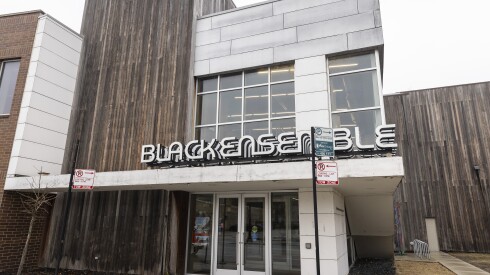Theater buffs in Chicago, even if they didn’t know John Morris personally, benefited from his work.
As an architect who specialized in theater design, his vision for connecting an audience with stage performances came to life at numerous theaters in Chicago, including Black Ensemble Theater, Steppenwolf Theatre and Lookingglass Theatre, just a tiny sample.
Black Ensemble Theater founder and artistic director Jackie Taylor said she knew Mr. Morris was the only person she wanted for the job years before she hired him.
“I wanted a building where people could just look at it and feel the energy and the love that comes from it, and John delivered,” Taylor said. “He was also just a very kind, loving and trustworthy human being.”
Mr. Morris died Aug. 23 from complications of pancreatic cancer. He was 77.
“He understood how to make theaters, how to make that connection between the actors and the audience as intimate an experience as possible, as powerful as possible,” said Patrick Danaher, managing architect at Mr. Morris’ firm, Morris Architects Planners.
“He got so good at it that he’d walk into a building, look at the space and instantly he knew the best layout in his head, then we’d go back the office, he’d do a quick sketch, I’d draw it up and I’d be like ‘OK, can it be done better if we put something over here or over there?’ Then I’d test it out and it always turned out that he got it right from the beginning,” Danaher recalled. “It was spot on, everything was in the right place from the get-go.”
Mr. Morris designed the performance space at the Old Town School of Folk Music on Lincoln Avenue, a space previously occupied by the Hild Regional Branch of the Chicago Public Library. He also helped design the Chicago Magic Lounge and the whimsical secret door that looks like stacked laundromat machines — a nod to the building’s previous occupant: a commercial laundry.
Joey Cranford, co-owner of the Magic Lounge, recalled hashing out the ideal stage height for magic and jumping up on Mr. Morris’ desk — which matched the proposed height — to pantomime a card trick in order to see if guests in the front row would be able to see.
It turned out that Mr. Morris, playing a patron, couldn’t see the trick’s big finish.
“Because he was willing to play with me like that, we now have the perfect stage,” Cranford said.
“He really invested in and cared about helping the theater community in Chicago develop over the years,” Cranford said.
“I also think it’s also important to note how much of a mentor he was to so many young architects,” Danaher said, noting a lineage of designers who can point to time spent with Mr. Morris as a catalyst in their careers.
Mr. Morris was born April 18, 1948, in Detroit, Mich., to LaVanche and Bill Morris. She was a homemaker. He worked for a phone company.
He grew up in Midland, Mich., and studied political science at Oakland University in the Detroit area.
Through a series of odd jobs he learned carpentry and began building theater sets, which quickly became his passion.
In the early ’70s he moved to Chicago and began working at the Goodman Theatre. While employed there, he opened his own scenery shop, working with theaters all over Chicago.
He later enrolled in an architecture program at University of Illinois at Chicago and soon after graduating connected with Second City co-founder Bernard Sahlins, who put Mr. Morris in touch with an architect pal of his, George Veronda, who quickly hired him.
After working with several different partners, Mr. Morris, who lived in Ravenswood, opened his own firm in 1992.
He designed the American Blues Theater, the Windy City Playhouse theater and the theater at the Beverly Arts Center.
“He was always focused on expanding the number of seats while keeping the furthest seat as close to the stage as possible,” said his child, Sarah Morris.
He also designed the Green Line Performing Arts Center at the University of Chicago, and auditoriums for the Francis W. Parker School and the North Shore Country Day School.
The names of theaters he worked on is too long to list here.
Mr. Morris’s firm is in the process of shutting down operations, said his son Dan Morris.
Even toward the end of his life Mr. Morris maintained a keen sense of humor, Sarah Morris said.
Mr. Morris loved skiing, spending time in Northwest Michigan and playing with his grandchildren, who called him “Popsicle.”
Mr. Morris is also survived by his wife, Claudia, and another son, Peter Morris, as well as three grandchildren.
A celebration of life is being planned for next spring.
